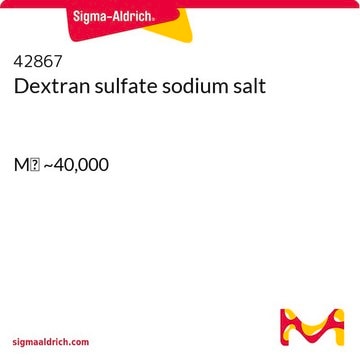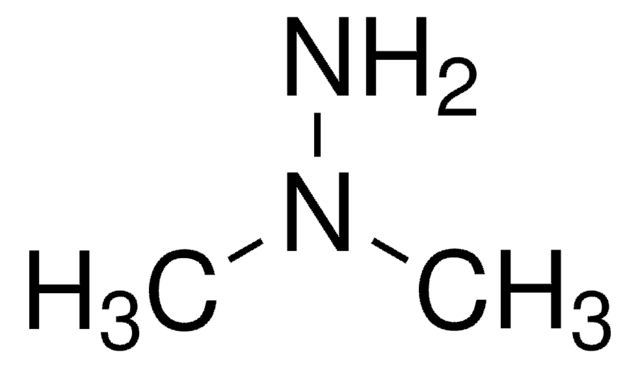A2853
Azossimetano
Practical grade, 13.4 M, ≥90% (GC)
Sinonimo/i:
AOM
About This Item
Prodotti consigliati
Saggio
≥90% (GC)
Qualità
Practical grade
contiene
≤15% ethanol and acetic acid (Packaged based on azoxymethane.)
Composizione
methylene chloride, ≤5% (solvent)
Concentrazione
13.4 M
P. eboll.
97-99 °C (lit.)
Densità
0.991 g/mL at 25 °C (lit.)
Temperatura di conservazione
−20°C
Stringa SMILE
C\N=[N+](/C)[O-]
InChI
1S/C2H6N2O/c1-3-4(2)5/h1-2H3/b4-3+
DGAKHGXRMXWHBX-ONEGZZNKSA-N
Cerchi prodotti simili? Visita Guida al confronto tra prodotti
Azioni biochim/fisiol
Avvertenze
Danger
Indicazioni di pericolo
Consigli di prudenza
Classi di pericolo
Acute Tox. 2 Oral - Carc. 1B - Eye Irrit. 2 - Flam. Liq. 3 - Repr. 2 - Skin Irrit. 2
Codice della classe di stoccaggio
3 - Flammable liquids
Classe di pericolosità dell'acqua (WGK)
WGK 3
Punto d’infiammabilità (°F)
75.2 °F
Punto d’infiammabilità (°C)
24 °C
Dispositivi di protezione individuale
Faceshields, Gloves, Goggles, type ABEK (EN14387) respirator filter
Certificati d'analisi (COA)
Cerca il Certificati d'analisi (COA) digitando il numero di lotto/batch corrispondente. I numeri di lotto o di batch sono stampati sull'etichetta dei prodotti dopo la parola ‘Lotto’ o ‘Batch’.
Possiedi già questo prodotto?
I documenti relativi ai prodotti acquistati recentemente sono disponibili nell’Archivio dei documenti.
How does the storage temperature relate to shipping conditions?
The storage conditions that a Sigma-Aldrich catalog and label recommend for products are deliberately conservative. For many products, long-term storage at low temperatures will increase the time during which they are expected to remain in specification and therefore are labeled accordingly. Where short-term storage, shipping time frame, or exposure to conditions other than those recommended for long-term storage will not affect product quality, Sigma-Aldrich will ship at ambient temperature. The products sensitive to short-term exposure to conditions other than their recommended long-term storage are shipped on wet or dry ice. Ambient temperature shipping helps to control shipping costs for our customers. At any time, our customers can request wet- or dry-ice shipment, but the special handling is at customer expense if our product history indicates that the product is stable for regular shipment. See Shipping and Storage for more information.
Which document(s) contains shelf-life or expiration date information for a given product?
If available for a given product, the recommended re-test date or the expiration date can be found on the Certificate of Analysis.
How do I get lot-specific information or a Certificate of Analysis?
The lot specific COA document can be found by entering the lot number above under the "Documents" section.
How do I find price and availability?
There are several ways to find pricing and availability for our products. Once you log onto our website, you will find the price and availability displayed on the product detail page. You can contact any of our Customer Sales and Service offices to receive a quote. USA customers: 1-800-325-3010 or view local office numbers.
What is the Department of Transportation shipping information for this product?
Transportation information can be found in Section 14 of the product's (M)SDS.To access the shipping information for this material, use the link on the product detail page for the product.
What solvents can be used to dissolve Azoxymethane?
Azoxymethane is soluble in water, ether, ethanol, and chloroform. The reported solubility in chlorform is 200 mg/mL, and in water is 100 mg/mL.
How should stock solutions of Azoxymethane be stored, and for how long can they be kept?
No solution stability studies have been performed by Sigma-Aldrich. Because the solution stability is unknown, solutions should be prepared fresh for use.
How does azoxymethane act to cause cancers?
Azoxymethane is a methylating agent which forms 6-O-methylguanine in DNA. Unless this methylated base is repaired by cellular enzymes, it results in a base mismatch that subsequently causes tumors in the tissue.
My question is not addressed here, how can I contact Technical Service for assistance?
Ask a Scientist here.
Il team dei nostri ricercatori vanta grande esperienza in tutte le aree della ricerca quali Life Science, scienza dei materiali, sintesi chimica, cromatografia, discipline analitiche, ecc..
Contatta l'Assistenza Tecnica.











